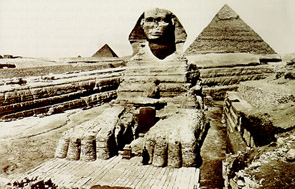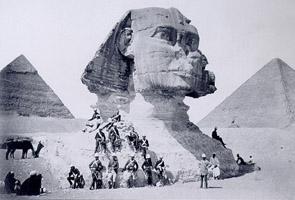|
Giza
Sphinx in Pictures
PAGE 3
|
It
was partly to give tourists something extra to see in Lower
Egypt (which, despite the pyramids, could not rival Upper
Egypt for spectacular ruins) that Maspero undertook further
excavations at the Sphinx in 1885. After that, the Sphinx
remained on fuller view than before. A photograph by Lekegian
documents the erosion of the southern flank of the Sphinx,
with the cavernous fissure of the haunches at the left, and
shows the ancient masonry work that was added to build up
the eroded body of the monument.
Another photograph of the time shows the Dream Stela covered
over with a dark cloth (its upper part at least) to protect
the design at the top of the inscription, if not all of the
inscription itself. Masonry lies between the paws and in front
of the little altar discovered by Caviglia: presumably remains
(afterwards relaid) of the paving of Roman times. A tiny figure
in his black djellaba sits at the neck in the shade of the
massive head, giving an unusually good idea of the colossal
scale of the monument.
Baraize's work from 1925 into the early '30s achieved a more
complete clearance of the immediate Sphinx enclosure than
had been made before in modern times. A photograph from the
late '20s shows, most strikingly, the Roman-period paving
of the area in front of the Sphinx. The Sphinx's head (now
favoured with the cement extensions of the head-dress) is
framed between the Khafre and Menkaure pyramids like Horus
on the Horizon. This photograph was taken with a wide-angle
lens that has exaggerated the size of the paws in relation
to the chest and head, but it has made it possible to see
very clearly the eroded nature of the south wall, in particular,
of the immediate Sphinx enclosure and the way, behind the
Sphinx, that the strata rise to the north (they also rise
to the west).

The
Sphinx as revealed by the clearances (and restorations)
of Baraize inthe late 1920's. Photo: Lehnert and Landrock |
On top of the north face of the immediate Sphinx enclosure
(to the right in the photograph) Baraize's extra walling can
be seen: it was removal of this walling in the area at the
bottom right of this photograph that revealed how the south-west
corner of the temple of Amenophis II overhung the corridor
leading to the Sphinx from the original Sphinx temple (beneath
our feet in this photograph and cleared later on by Baraize
and then by Selim Hassan).
|
 |
To add to the questionable effect of the cement head-dress
extensions added by Baraize, the Second World War saw the
building of a pier up the Sphinx's breast, topped with sandbags,
to support the head against, one supposes, the threat of bomb
blast.
The
wartime photograph also shows the location before the recent
road was made up to the Great Pyramid. Just over the Sphinx's
left shoulder can be seen the end of an ancient mud-brick
wall: beyond it is the continuing western face of the wider
Sphinx enclosure.
At
the extreme right are some of the tombs cut into the north
face of the Sphinx enclosure that Professor Selim Hassan held
to indicate that the enclosure (and therefore the Sphinx)
were not cut out after Old Kingdom times.

The
Sphinx by sebah, in the second half of the nineteenth
century |
A
modern colour photograph shows the present state of the Sphinx,
lying in its highly eroded state in its immediate deep-cut
enclosure, with the pyramid of Khafre to the left (with some
of its casing still in place at the top) and the pyramid of
Khufu to the right.
The
built-on elements of the monument, including the tail curling
up at the haunches and the box at bottom left-center that
is probably a New Kingdom shrine-base (for a statue of Osiris)
contrast with the very worn state of the living rock of the
body. Over the fully clad foreleg at bottom right, the top
of the Dream Stela of Tuthmosis IV can be seen. (Above that
in the distance at the foot of the Great Pyramid we can see
the museum housing the wooden boat of Khufu found nearby.)

The
Sphinx by Fiorillo, 1882 |
|